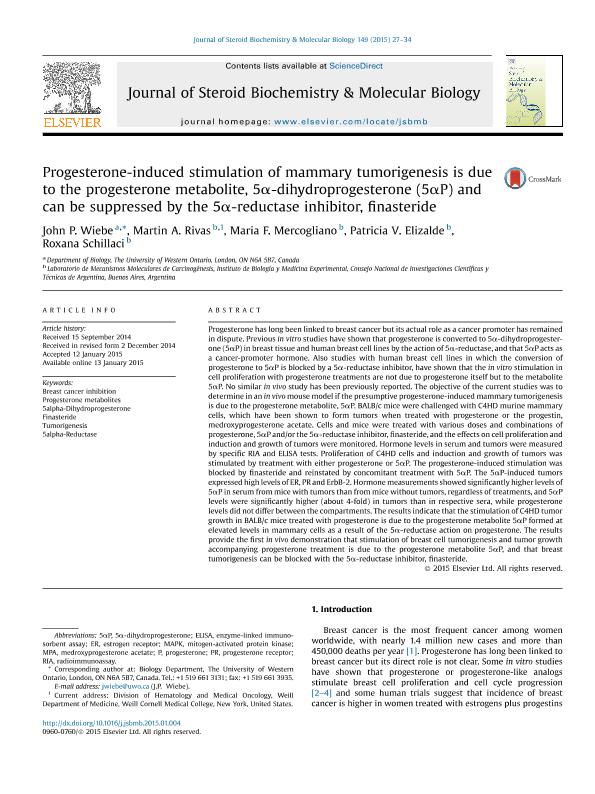Mostrar el registro sencillo del ítem
dc.contributor.author
Wiebe, John P.
dc.contributor.author
Rivas, Martin Alfredo

dc.contributor.author
Mercogliano, María Florencia

dc.contributor.author
Elizalde, Patricia Virginia

dc.contributor.author
Schillaci, Roxana

dc.date.available
2017-08-25T20:51:15Z
dc.date.issued
2015-05
dc.identifier.citation
Wiebe, John P.; Rivas, Martin Alfredo; Mercogliano, María Florencia; Elizalde, Patricia Virginia; Schillaci, Roxana; Progesterone-induced stimulation of mammary tumorigenesis is due to the progesterone metabolite, 5α-dihydroprogesterone (5αP) and can be suppressed by the 5α-reductase inhibitor, finasteride; Elsevier; Journal of Steroid Biochemistry and Molecular Biology; 149; 5-2015; 27-34
dc.identifier.issn
0960-0760
dc.identifier.uri
http://hdl.handle.net/11336/23051
dc.description.abstract
Progesterone has long been linked to breast cancer but its actual role as a cancer promoter has remained in dispute. Previous in vitro studies have shown that progesterone is converted to 5a-dihydroprogesterone (5aP) in breast tissue and human breast cell lines by the action of 5 a-reductase, and that 5aP acts as a cancer-promoter hormone. Also studies with human breast cell lines in which the conversion of progesterone to 5aP is blocked by a 5a-reductase inhibitor, have shown that the in vitro stimulation in cell proliferation with progesterone treatments are not due to progesterone itself but to the metabolite 5aP. No similar in vivo study has been previously reported. The objective of the current studies was to determine in an in vivo mouse model if the presumptive progesterone-induced mammary tumorigenesis is due to the progesterone metabolite, 5aP. BALB/c mice were challenged with C4HD murine mammary cells, which have been shown to form tumors when treated with progesterone or the progestin, medroxyprogesterone acetate. Cells and mice were treated with various doses and combinations of progesterone, 5aP and/or the 5 a-reductase inhibitor, finasteride, and the effects on cell proliferation and induction and growth of tumors were monitored. Hormone levels in serum and tumors were measured by specific RIA and ELISA tests. Proliferation of C4HD cells and induction and growth of tumors was stimulated by treatment with either progesterone or 5aP. The progesterone-induced stimulation was blocked by finasteride and reinstated by concomitant treatment with 5aP. The 5aP-induced tumors expressed high levels of ER, PR and ErbB-2. Hormone measurements showed significantly higher levels of 5aP in serum from mice with tumors than from mice without tumors, regardless of treatments, and 5aP levels were significantly higher (about 4-fold) in tumors than in respective sera, while progesterone levels did not differ between the compartments. The results indicate that the stimulation of C4HD tumor growth in BALB/c mice treated with progesterone is due to the progesterone metabolite 5aP formed at elevated levels in mammary cells as a result of the 5a-reductase action on progesterone. The results provide the first in vivo demonstration that stimulation of breast cell tumorigenesis and tumor growth accompanying progesterone treatment is due to the progesterone metabolite 5aP, and that breast tumorigenesis can be blocked with the 5a-reductase inhibitor, finasteride.
dc.format
application/pdf
dc.language.iso
eng
dc.publisher
Elsevier

dc.rights
info:eu-repo/semantics/openAccess
dc.rights.uri
https://creativecommons.org/licenses/by-nc-sa/2.5/ar/
dc.subject
Metabolites
dc.subject
Progesterone
dc.subject
Breast Cancer
dc.subject.classification
Bioquímica y Biología Molecular

dc.subject.classification
Medicina Básica

dc.subject.classification
CIENCIAS MÉDICAS Y DE LA SALUD

dc.title
Progesterone-induced stimulation of mammary tumorigenesis is due to the progesterone metabolite, 5α-dihydroprogesterone (5αP) and can be suppressed by the 5α-reductase inhibitor, finasteride
dc.type
info:eu-repo/semantics/article
dc.type
info:ar-repo/semantics/artículo
dc.type
info:eu-repo/semantics/publishedVersion
dc.date.updated
2017-08-09T16:57:29Z
dc.identifier.eissn
1879-1220
dc.journal.volume
149
dc.journal.pagination
27-34
dc.journal.pais
Países Bajos

dc.journal.ciudad
Amsterdam
dc.description.fil
Fil: Wiebe, John P.. University of Wenstern Ontario. Department of Biology; Canadá
dc.description.fil
Fil: Rivas, Martin Alfredo. Consejo Nacional de Investigaciones Científicas y Técnicas. Instituto de Biología y Medicina Experimental. Fundación de Instituto de Biología y Medicina Experimental. Instituto de Biología y Medicina Experimental; Argentina
dc.description.fil
Fil: Mercogliano, María Florencia. Consejo Nacional de Investigaciones Científicas y Técnicas. Instituto de Biología y Medicina Experimental. Fundación de Instituto de Biología y Medicina Experimental. Instituto de Biología y Medicina Experimental; Argentina
dc.description.fil
Fil: Elizalde, Patricia Virginia. Consejo Nacional de Investigaciones Científicas y Técnicas. Instituto de Biología y Medicina Experimental. Fundación de Instituto de Biología y Medicina Experimental. Instituto de Biología y Medicina Experimental; Argentina
dc.description.fil
Fil: Schillaci, Roxana. Consejo Nacional de Investigaciones Científicas y Técnicas. Instituto de Biología y Medicina Experimental. Fundación de Instituto de Biología y Medicina Experimental. Instituto de Biología y Medicina Experimental; Argentina
dc.journal.title
Journal of Steroid Biochemistry and Molecular Biology

dc.relation.alternativeid
info:eu-repo/semantics/altIdentifier/url/http://www.sciencedirect.com/science/article/pii/S0960076015000060
dc.relation.alternativeid
info:eu-repo/semantics/altIdentifier/doi/http://dx.doi.org/10.1016/j.jsbmb.2015.01.004
dc.relation.alternativeid
info:eu-repo/semantics/altIdentifier/pmid/25595041
Archivos asociados
